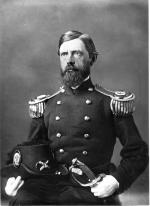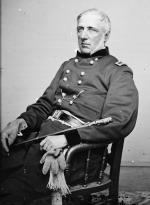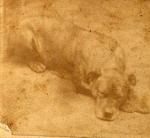![header=[Marker Text] body=[The Union Army 1st Corps camped here June 30, 1863, on the way to Gettysburg. Followed later by the 11th and 3rd Corps, they marched next morning to relieve Buford's cavalry, already in action west of the town.] sign](http://explorepahistory.com/kora/files/1/10/1-A-1FA-139-ExplorePAHistory-a0h2q7-a_450.jpg)
Mouse over for marker text
Name:
Gettysburg Campaign [First Corps]
Region:
Hershey/Gettysburg/Dutch Country Region
County:
Adams
Marker Location:
Old US Route 15 near Marsh Creek, south of Gettysburg
Dedication Date:
December 18, 1947
Behind the Marker
June 30, 1863, was a day of paperwork for the Army of the Potomac. According to Regulations, on the last day of every other month, each and every unit in the army was to be mustered for pay. This meant that each unit was lined up and the roll call made. Then, the company clerks got busy.
They wrote up the list of officers and men both present and absent (usually sick or on detached duty) who were entitled to receive their pay, then accounted for every change that had occurred in the unit since the last pay muster. Without the benefit of typewriters–yet to be invented–they filled out each muster form by hand, in triplicate. (One copy the company retained; the other two went to the paymaster of the army.) Then, the men waited to be paid. And more often than not, the government paymasters failed to appear on schedule. Soldiers could wait months between pay days.
The First Corps, led by Major General John F. Reynolds started this lengthy process in their camps around Emmitsburg, Maryland. Orders for the day from the army commander,
Major General John F. Reynolds started this lengthy process in their camps around Emmitsburg, Maryland. Orders for the day from the army commander,  George G. Meade specified that the First Corps would march partway to Gettysburg, Pennsylvania, and be within supporting distance for General John Buford's cavalry, which was heading into Gettysburg in search of the enemy. So, the men of the corps considered the last day of June their lucky day, for the march from Emmitsburg north across the Mason-Dixon Line was only a few miles, six miles for two divisions, and eight for the First Division of the corps.
George G. Meade specified that the First Corps would march partway to Gettysburg, Pennsylvania, and be within supporting distance for General John Buford's cavalry, which was heading into Gettysburg in search of the enemy. So, the men of the corps considered the last day of June their lucky day, for the march from Emmitsburg north across the Mason-Dixon Line was only a few miles, six miles for two divisions, and eight for the First Division of the corps.
By mid-afternoon, the soldiers of the First Corps had finished their march and set up camps along the banks of Marsh Creek. Two divisions camped around a local establishment called Moritz Tavern, which General Reynolds took as his headquarters. The First Division moved two miles up the road to find a suitable campsite.
The strength of the corps on June 30 totaled around 11,000 troops and twenty-eight cannon. New York politician-turned-soldier James Wadsworth, age fifty-five, led the First Division, which camped only six miles from Gettysburg. One of Wadsworth's two brigades was arguably the best-known in the entire army.
Nicknamed the "Iron Brigade," it contained three regiments from Wisconsin, one from Indiana, and one from Michigan. Instead of wearing the normal army headgear, the brigade sported the Hardee Hat, a black felt hat usually reserved for dress occasions. Wadsworth's other brigade contained men from Indiana, New York, and Pennsylvania. When the corps moved to Gettysburg on July 1, Wadsworth's infantry would be the first to arrive and contest the Rebel advance.
Since General Meade had asked Reynolds to command the army's left wing (his own corps plus the Third and Eleventh), Major General Abner Doubleday was in tactical command of the First Corps. A competent if unspectacular officer, Doubleday–later wrongly regarded as the man who invented baseball– was in charge of the corps' Third Division, two small brigades of New Yorkers and Pennsylvanians.
The Second Brigade contained the 149th and 150th Pennsylvania, extensions of the celebrated Bucktails, which was officered by men promoted from the original regiment. However, the original Bucktails (42nd Pennsylvania) disdained these two new regiments of soldiers and derisively called them the "Bogus Bucktails."
Bucktails, which was officered by men promoted from the original regiment. However, the original Bucktails (42nd Pennsylvania) disdained these two new regiments of soldiers and derisively called them the "Bogus Bucktails."
Reynolds' Second Division, also composed of two brigades, was headed by General John C. Robinson, a West Pointer with Mexican War experience, who had compiled a solid combat record thus far in the civil war. Robinson's men hailed from Maine, Massachusetts, New York, and Pennsylvania. Colonel Charles S. Wainwright was in command of the corps artillery brigade, five batteries of veteran artillerists who would contribute mightily to the upcoming battle.
The men of the First Corps spent the rest of the day writing letters, relaxing, and wondering about the future. Officers spent their time filling out forms that needed their attention.
July 1 dawned warm with some local rain showers scattered across southern Pennsylvania. General Reynolds was up early to read the latest dispatches from army headquarters and to be ready to execute Meade's orders for the day. Meade instructed Reynolds to march his First Corps to Gettysburg, and move the Eleventh close to Gettysburg. The Third Corps would halt at Emmitsburg. Shortly after eight o'clock that morning, Reynolds, on horseback, was on his way to Gettysburg. Wadsworth's men soon followed, and then Robinson's, while Doubleday's troops headed off on a parallel road to make better time.
Reynolds arrived in Gettysburg to the noise of battle. John Buford's cavalrymen were disputing the Confederate advance from the west. Quickly assessing the situation, Reynolds sent word for Wadsworth to double-quick his men to the battle, which escalated upon their arrival.
By day's end, only 4,000 men were left of the 10,000 who had marched into battle. The celebrated Iron Brigade, 1,829 strong at the beginning of the day, had lost 1,153 soldiers. Confederate losses were equally as heavy. The first day of battle was horrific to those who survived. The remaining two days would not be any better.
They wrote up the list of officers and men both present and absent (usually sick or on detached duty) who were entitled to receive their pay, then accounted for every change that had occurred in the unit since the last pay muster. Without the benefit of typewriters–yet to be invented–they filled out each muster form by hand, in triplicate. (One copy the company retained; the other two went to the paymaster of the army.) Then, the men waited to be paid. And more often than not, the government paymasters failed to appear on schedule. Soldiers could wait months between pay days.
The First Corps, led by
By mid-afternoon, the soldiers of the First Corps had finished their march and set up camps along the banks of Marsh Creek. Two divisions camped around a local establishment called Moritz Tavern, which General Reynolds took as his headquarters. The First Division moved two miles up the road to find a suitable campsite.
The strength of the corps on June 30 totaled around 11,000 troops and twenty-eight cannon. New York politician-turned-soldier James Wadsworth, age fifty-five, led the First Division, which camped only six miles from Gettysburg. One of Wadsworth's two brigades was arguably the best-known in the entire army.
Nicknamed the "Iron Brigade," it contained three regiments from Wisconsin, one from Indiana, and one from Michigan. Instead of wearing the normal army headgear, the brigade sported the Hardee Hat, a black felt hat usually reserved for dress occasions. Wadsworth's other brigade contained men from Indiana, New York, and Pennsylvania. When the corps moved to Gettysburg on July 1, Wadsworth's infantry would be the first to arrive and contest the Rebel advance.
Since General Meade had asked Reynolds to command the army's left wing (his own corps plus the Third and Eleventh), Major General Abner Doubleday was in tactical command of the First Corps. A competent if unspectacular officer, Doubleday–later wrongly regarded as the man who invented baseball– was in charge of the corps' Third Division, two small brigades of New Yorkers and Pennsylvanians.
The Second Brigade contained the 149th and 150th Pennsylvania, extensions of the celebrated
Reynolds' Second Division, also composed of two brigades, was headed by General John C. Robinson, a West Pointer with Mexican War experience, who had compiled a solid combat record thus far in the civil war. Robinson's men hailed from Maine, Massachusetts, New York, and Pennsylvania. Colonel Charles S. Wainwright was in command of the corps artillery brigade, five batteries of veteran artillerists who would contribute mightily to the upcoming battle.
The men of the First Corps spent the rest of the day writing letters, relaxing, and wondering about the future. Officers spent their time filling out forms that needed their attention.
July 1 dawned warm with some local rain showers scattered across southern Pennsylvania. General Reynolds was up early to read the latest dispatches from army headquarters and to be ready to execute Meade's orders for the day. Meade instructed Reynolds to march his First Corps to Gettysburg, and move the Eleventh close to Gettysburg. The Third Corps would halt at Emmitsburg. Shortly after eight o'clock that morning, Reynolds, on horseback, was on his way to Gettysburg. Wadsworth's men soon followed, and then Robinson's, while Doubleday's troops headed off on a parallel road to make better time.
Reynolds arrived in Gettysburg to the noise of battle. John Buford's cavalrymen were disputing the Confederate advance from the west. Quickly assessing the situation, Reynolds sent word for Wadsworth to double-quick his men to the battle, which escalated upon their arrival.
By day's end, only 4,000 men were left of the 10,000 who had marched into battle. The celebrated Iron Brigade, 1,829 strong at the beginning of the day, had lost 1,153 soldiers. Confederate losses were equally as heavy. The first day of battle was horrific to those who survived. The remaining two days would not be any better.




![Camp life of the 31st Pennsylvania regiment [Stereograph]Brady and Co.(Washington, D.C.),ca.1861-ca.1865,Stereograph Soldiers with women and children outside of tents with personal belongings scattered around the camp site. Camp life of the 31st Pennsylvania regiment [Stereograph]Brady and Co.(Washington, D.C.),ca.1861-ca.1865,Stereograph Soldiers with women and children outside of tents with personal belongings scattered around the camp site.](http://cache.matrix.msu.edu/expa/small/1-2-86D-25-ExplorePAHistory-a0h4n2-a_349.jpg)




